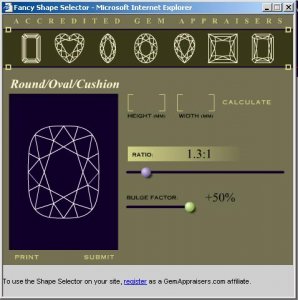You are using an out of date browser. It may not display this or other websites correctly.
You should upgrade or use an alternative browser.
You should upgrade or use an alternative browser.
Cuts & Shapes
- Thread starter yaro
- Start date
- Status
- Not open for further replies. Please create a new topic or request for this thread to be opened.
katbadness
Shiny_Rock
- Joined
- Jan 29, 2004
- Messages
- 480

Hmmm... I'm not sure how to answer what you're asking...
So, let me ask you for clarification, if you don't mind.
Are you looking to get more information on the different shapes that diamonds are cut or are you looking to gain knowledge on what makes a well cut stone for a specific diamond shape?

- Joined
- Aug 29, 2003
- Messages
- 15,808
----------------
On 4/26/2004 11:28:31 PM yaro wrote:
I am trying to understand the relationship of shapes and cuts.
----------------
I do not really understand this: "shape" is clear, "cuts" not really. Do you mean a tool to let you vary the cut proportions of each shape and see what they look like?
This would be the Gem Adviser - a little software toy. This is not free and I do not know of any free software doing this (you cna find a link somewhere on preciousmetals.com.au). There are other packages specialized in designing new cut models...
The next best ate two little applications: the "Fancy Ct Selector" at gemappraisers.com which let's you vary length, width and convexity for the top-down view of the traditional shapes, and the GemAdviser 2.0 files already put up to display the stones sold by GoodOldGold (very cool simmulation there


Sorry - let me clarify:
It seems that when I use the term "Round Brilliant" I am referring to the shape of the stone and the type of cut. "Round" speaks to the circular shape (no surpise there) and "Brilliant" to the 58 facets that make up the cut.
My understanding is that brilliant cuts can be used for shapes other than round. What I don't know is what shapes allow a brilliant cut and what don't. Maybe any shape allows a brilliant cut, but some shapes don't lend themselves to that particular cut.
Extrapolating this thought further, there are probably many combinations that are optimal, some that are forbiden by the geometry of the rough, and some that are possible but not advisable (or just not common).
I am looking to display this matrix in a table that something looks like this:
Cuts: Brilliant ... Step ... Princess ---->
Shapes
------
Round OK ... X ... X
...
Square Possible ... OK ... OK
|
|
V
Hope this clarifies.
Thanks.
Yaro
It seems that when I use the term "Round Brilliant" I am referring to the shape of the stone and the type of cut. "Round" speaks to the circular shape (no surpise there) and "Brilliant" to the 58 facets that make up the cut.
My understanding is that brilliant cuts can be used for shapes other than round. What I don't know is what shapes allow a brilliant cut and what don't. Maybe any shape allows a brilliant cut, but some shapes don't lend themselves to that particular cut.
Extrapolating this thought further, there are probably many combinations that are optimal, some that are forbiden by the geometry of the rough, and some that are possible but not advisable (or just not common).
I am looking to display this matrix in a table that something looks like this:
Cuts: Brilliant ... Step ... Princess ---->
Shapes
------
Round OK ... X ... X
...
Square Possible ... OK ... OK
|
|
V
Hope this clarifies.
Thanks.
Yaro
- Joined
- Aug 29, 2003
- Messages
- 15,808
Gee! Actually, this is a very well founded Q !
There are no rules made up yet for this, and many shapes are called "modified brilliant" for little reason. For example, the princess is a "square modified brilliant" even though it's facets are not a transformation of the RBC facet outline (meaning = you need extra poits in the 3D facet grid to get from one shape to another). The RBC can get modified into all the traditional "modified brilliants": oval, marquize, pear, cushion, square (radiant).
You may find three new attempts to modify the RBC pattern 'towards the square' while keeping optical properties in place: the Regent, Jubilee and Queen of Harts all want to be modifications of the RBC facet pattern towards a square outline in keeping with some (not published) constraints (related to optics). These three can be found on the GoodOldGold site. They are however good prof that one cannot move much from the round outline and keep the optics in place (those 'squares' are quite roundish, and the internal geometry has been a bit altered by extra facets).
Your question is solvable by constructing a system of constraints for the modified shape's optics - not something I could do at the click of a button. It does sound inetresting though and I bet that the guys behind the HCA and DiamCalc research have done this or could advise how to get it done (Leonid would know more, I suppose).

As of now, your matrix is fully covered.
Also, the respective "fancy cut selector" works by extruding the respective RBC crown pattern, just as you assume was done. However, this way of thinking is not inbuilt in the processs of diamond cut design and evaluation (at least was not until differential geometry and ray trace analysis hit this ground).
The constraints are up to you!
Hope this helps
 PM welcome
PM welcome

There are no rules made up yet for this, and many shapes are called "modified brilliant" for little reason. For example, the princess is a "square modified brilliant" even though it's facets are not a transformation of the RBC facet outline (meaning = you need extra poits in the 3D facet grid to get from one shape to another). The RBC can get modified into all the traditional "modified brilliants": oval, marquize, pear, cushion, square (radiant).
You may find three new attempts to modify the RBC pattern 'towards the square' while keeping optical properties in place: the Regent, Jubilee and Queen of Harts all want to be modifications of the RBC facet pattern towards a square outline in keeping with some (not published) constraints (related to optics). These three can be found on the GoodOldGold site. They are however good prof that one cannot move much from the round outline and keep the optics in place (those 'squares' are quite roundish, and the internal geometry has been a bit altered by extra facets).
Your question is solvable by constructing a system of constraints for the modified shape's optics - not something I could do at the click of a button. It does sound inetresting though and I bet that the guys behind the HCA and DiamCalc research have done this or could advise how to get it done (Leonid would know more, I suppose).

As of now, your matrix is fully covered.
Also, the respective "fancy cut selector" works by extruding the respective RBC crown pattern, just as you assume was done. However, this way of thinking is not inbuilt in the processs of diamond cut design and evaluation (at least was not until differential geometry and ray trace analysis hit this ground).
The constraints are up to you!
Hope this helps


- Joined
- Aug 29, 2003
- Messages
- 15,808
This is what I was talking about... all these are actual models one can find cut on the market, for better or wose. (below)
At a second glance, there seem to be two factors in your line up of "cuts": facet patters and facet number: one can have a brilliant with more or less than 58 facets, same for barion (the pattern name for what goes on a radiant and related) and step. The 'brilliant' word does not mean 'number of facets' but their arrangement and shape

The 'princess' is a brand name and the respective cut is a mixed model with no readily available 'other name' and no variants (it is in itself a concoction of a few basic types of faceting I suppose).
There must be somewhere a material on these faceting models (you might want to try the links on feceters.com for it).

At a second glance, there seem to be two factors in your line up of "cuts": facet patters and facet number: one can have a brilliant with more or less than 58 facets, same for barion (the pattern name for what goes on a radiant and related) and step. The 'brilliant' word does not mean 'number of facets' but their arrangement and shape

The 'princess' is a brand name and the respective cut is a mixed model with no readily available 'other name' and no variants (it is in itself a concoction of a few basic types of faceting I suppose).
There must be somewhere a material on these faceting models (you might want to try the links on feceters.com for it).

Hest88
Ideal_Rock
- Joined
- Jan 22, 2003
- Messages
- 4,357
Someone correct me if I'm wrong, but:
A step cut diamond is made of parallel facets.
A brilliant is triangular facets.
Of the common shapes (pear, marquise, etc.), only an emerald is a pure step cut because it is the only one that is purely made up of parallel facets, while most of the others are brilliants or hybrids (with both step cut facets and brilliants) such as the radiant.
A step cut diamond is made of parallel facets.
A brilliant is triangular facets.
Of the common shapes (pear, marquise, etc.), only an emerald is a pure step cut because it is the only one that is purely made up of parallel facets, while most of the others are brilliants or hybrids (with both step cut facets and brilliants) such as the radiant.
- Joined
- Aug 29, 2003
- Messages
- 15,808
----------------
On 4/27/2004 12:40:36 AM Hest88 wrote:
others are brilliants or hybrids (with both step cut facets and brilliants) ----------------
Some of the hybrids have names (key words such as barion, scissor, checkerboard, Portuguese... come to mind) more or less established. I don't think there is a clear cut classification of these.
As for 'constraints' - well, there are many more cut models and proportions possible than would ever be 'desirable' - up to you to define what 'desirable' is and how it translates into the geometry of one or another cut model - hence some constraints on how each shape might be cut emerge. Concepts such as 'white light return', 'brilliance', 'contrast', 'fire' and 'scintillation' have been indtroduced to pin down what makes the visual impact of a cut diamond and bring the issue down to such quantifiable constraints

The story about light return in diamonds does involve a set of constraints which make the round cut more brilliant. However, there does not seem to be any publicly available body of research about extending these constraints beyond the round shape. One can analyze cut models and design new ones to deliver improved brilliance. However, it seems that some generalization of the 'ideal cut' model for non-rounds has been deemed impractical and left a mater of hobbyists curiosity

This is about as much as my hunch goes... and corrections would be welcome

You may want to check Leonid's posts about OctoNus and "diamond charm"

- Status
- Not open for further replies. Please create a new topic or request for this thread to be opened.
Celebrating Mothers And Mentors This Mother's Day
Celebrating Mothers And Mentors This Mother's Day - 05/05





300x240.png)